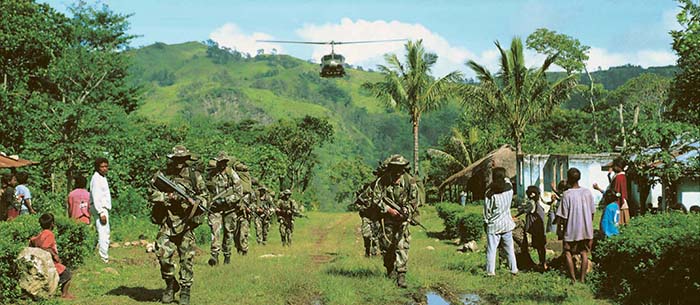An Irish East Timor Patrol. Photo courtesy Defense Forces HQ – PR Office
by Julio A. Montes
The first Irish military mission to Central America took place on 3 December 1989, when 57 elements of the Irish Defense Forces participated as part of ONUCA (United Nations Mission in Central America). In January 1992, elements of this mission took over tasks with the UN in El Salvador (ONUSAL). The Irish military forces have been an active participant of several UN missions in peace keeping and humanitarian tasks, and we can mention Lebanon, the Balkans, Timor and Central America. These activities in hostile lands and the experiences with the emergency in Northern Ireland, however, have also brought the realization that the nation is not immune to terrorist activities.
At Dublin I was met by Adrian J. English and Richard Cullen1, both old friends who would be my guides. They had coordinated with Lt. Col. Patrick Herbert2 of the Armed Forces Public Affairs Office for visits to several military installations, and Captain Fred O’Donovan is assigned as our liaison.
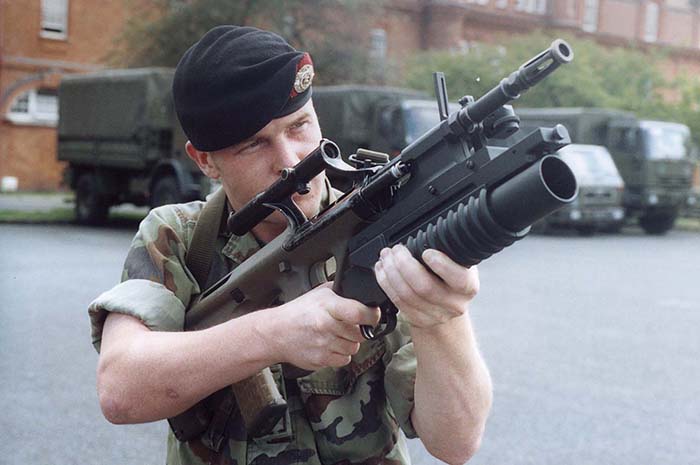
THE TERRITORIAL FORCES
The Óglaigh na hÉireann (Irish Defence3 Forces) includes the Army, the Irish Air Corps and the Naval Service. Total authorized strength of the Defense Forces is now 10,780 of which there are 8,706 for the Army, 1,144 for the Navy and 930 for the Air Corps. The Army has a twofold mission: the defense of the national territory and support the Garda Siochana (police). There are three brigades’ headquarters and the National Training Centre.
The 1st Brigade has jurisdiction over the southern counties of Kerry, Cork, Limerick, Waterford, Tipperery, Laois, Carlow, Kilkenny and Wexford. The 2nd Brigade operates in the eastern counties of Kildare, Wicklow, Monaghan, Meath, and Dublin. The 4th Brigade is responsible for the western counties of Donegal, Cavan, Mayo, Sligo, Letrim, Roscommon, Calway, Longford, Westmeath and Offaly.
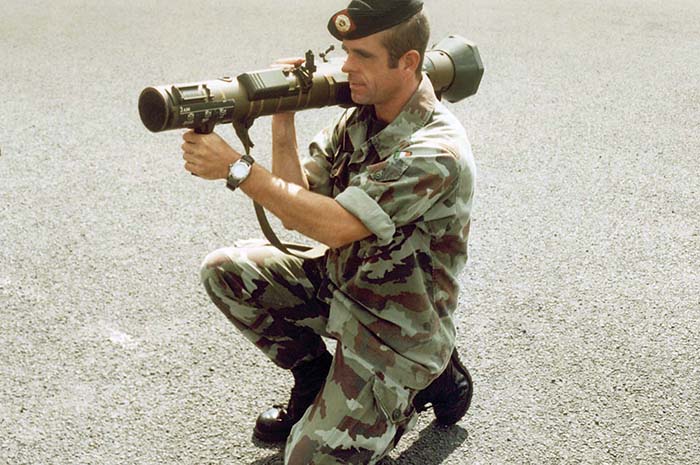
THE CURRAGH
The Curragh is extended and surrounded by large tracks of green pasture. So large are the fields that a local joke says that here at the Curragh there are only sheep, shit and soldiers. Commandant Eamon O’Siochru tells us that there could be up to 4,500 elements in various phases of training or deployment at the Curragh, making it the most important military installation in the Republic.
The premier anti-terrorist unit of the Irish Defence Forces is the Sciathán Fianóglach an Airm, or Army Ranger Wing, based here. The Irish indicate that there is no exact equivalent to Fianóglach but “Ranger” is widely accepted as its closest translation. The Rangers trace their lineage to the Legendary Irish Warriors (Na Fianna).
The Army Ranger Wing was established in March 1980 by the Defense Act, after a nucleus of operators was trained at Fort Benning, Georgia, by the US Army Rangers. It remains a very secretive unit, tasked with conventional, unconventional and police support missions. Some of the conventional tasks in conventional warfare include security of vital objectives, patrol and long range reconnaissance, ambushes, sabotage, capture of important enemy assets, delay operations, intelligence gathering, and VIP protection, counterinsurgency, planning and training of special operations.
Rangers attend an initial selection course of four weeks. Those chosen will then attend six months of additional training. The emphasis is in shooting, first aid, use of explosives, advanced navigation, parachuting, communications and many other topics. Some of the ARW are specialists in HALO and HAHO while others attend diving training with the Naval Service Diving Section. Snipers attend a seven-week course.
It is believed that the ARW has about 100 operators (the actual number is secret) divided in two assault platoons. Each of them comprises five assault teams of 3 or 4 commandos. There is also a support platoon, with aviation assets, and explosive disposal experts attached to it. The unit maintains close ties and exchange programs with the US Army 1st SFOD-D, and 75th Rangers, as well as with the French GIGN, and Dutch BBE.
The standard side arm for the Rangers is the reliable Sig-Sauer P-226. The P-226 has its origins in the P-220 and P-225 pistols. The P-226 is supplemented with the Browning HP, also in 9x19mm Parabellum.
Until a few years ago the Irish soldier fielded the Swedish Carl-Gustav KPist M45, but the MP5 is now the standard submachine gun. The M45 fires 9x19mm Parabellum ammunition, fed by a 36-round staggered-column, two-position-feed, detachable box-type magazine, and weights 9 pounds, loaded. Although the police use the Uzi as standard equipment, this weapon has never been used by the military. The UZI weights 7.7 pounds, and has a cyclic rate of 600 rpm. The Irish Rangers use the MP5 in several versions, including retractable stock, silenced (MP5SD), and short machine pistol (MP5K). The submachine gun weights 5.6 pounds without ammunition, and has a cyclic rate of 800 rpm. The weapon is fed by 15- or 30-round magazines, and has an effective range of 200 meters. Heckler & Koch also produces the HK53. This is a short rifle rather than a submachine gun, but the barrel is only 50mm longer than the MP5. The HK53 fires the more powerful 5.56x45mm cartridge and has a cyclic rate of 700 rpm. For precision shooting, the Rangers use the HK 33/SG1. The HK33 variant was developed in 1985, and is basically a scaled-down G3 rifle in 5.56x45mm caliber. The SG1 variant weights 8 pounds, and is a refined and precise variant of the standard rifle. Both the HK53 and the HK33 make use of 25- and 40-round box magazines. The MP5, HK-53 and HK33 are designed by Heckler & Koch GmbH of Germany and all use the roller locking system.
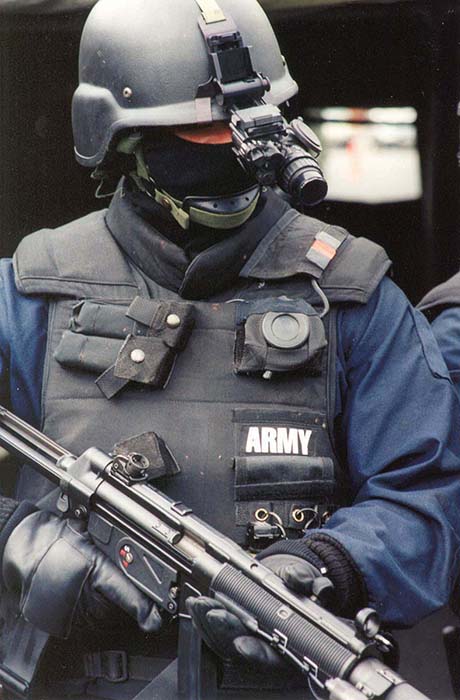
The 12 gauge Remington 870 is used for CQB and as an entry weapon, equipped with an 8-round extended tubular magazine.
The Cavalry is in charge of VIP security escort and rapid deployment not only in support of the ARW, but also of the other elements of the Army. The Army is in a transitional process at this time, and it is experiencing difficulties with troop allocations and budget cuts while the politicians increase missions and tasks. Nevertheless, this has resulted in some improvements. Commandant Bergin explained that with the new emphasis in international participation in UN-sponsored missions, each battalion is scheduled to receive about 15 MOWAG III armored vehicles. While explaining and praising the qualities of the Scorpion light tank here at the Curragh, Captain Cooke told us that the Cavalry will also retain a few modernized AML-90 and AML-20 vehicles.
OTHER ELITE UNITS
Commodore Frank Lynch and his second in command, Captain James Robinson, told us that the Naval Service includes the Diving Team. This unit at the moment comprises some twenty men. They remain quite busy detonating mines and ordnance left over from World War II. The Team also provides specialized training to the ARW in diving and underwater explosives and operations. In turn, ARW operators provide classes to those assigned to the boarding parties.
The naval flotilla includes 8 patrol ships, and there is hope that two new multipurpose vessels4 be accepted as replacement of the older patrol boats that are nearing the end of their useful lives. Each ship of the Naval Service has a Boarding Team of nine men. An officer and an NCO are used to board fishing boats, but the complete team of nine is utilized when boarding suspecting contraband and drug traffic vessels. The teams are equipped with Gecko or Israeli ballistic helmets, black nomex suits, and small arms when boarding suspected drug runners. They prefer the Browning High Power, but the AUG is also available.
The Irish Infantry Battalion comprises 473 elements5, divided in one HHC and two regular companies (A & B Coys), and one reservist company (C Coy). The spearhead of the battalion will be in the near future a mechanized MOWAG III company. For now, the eyes and spearheading force of the Battalion remains the elite Recon Platoon. Captain Fred O’Donovan took us to McKee Barracks in Dublin, where the commander of the 5th Infantry Battalion welcomed us and presented his Recce Platoon for the demonstrations.
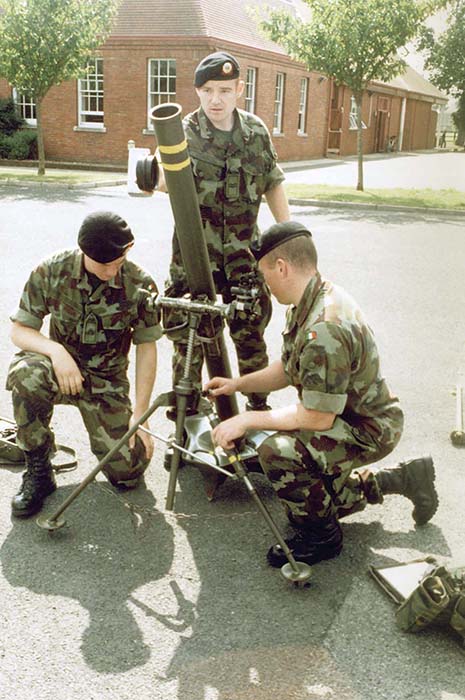
The FN FAL has been declared obsolete, and it has been replaced with the Steyr AUG in 5.56x45mm. This rifle can easily accommodate the 40mm M203 PI grenade launcher, and it comes equipped with a Swarovski 1.5-power optical sight as part of the carry handle.
Another advantage of the AUG is that it basically consists of a weapon system, which simplifies maintenance, logistics and training. A simple change of accessories can convert the standard rifle to a 9x19mm submachine gun. A barrel change can transform the standard rifle (with a barrel length of 508mm) to a short rifle (with a 350mm barrel), or a Carbine (407mm barrel). The pullpup design makes the AUG very compact and ideal for mounted or heliborne operations.
For sustained fire support, the Irish use the FN MAG 58 GPMG (called here the MAG-80), and the Rangers have selected the FN Minimi SAW. Elements of the Recce Platoon, 5th Infantry Battalion at McKee Barracks indicated that the force had examined the AUG light machine gun (621mm barrel with bipod) but decided against it.
For indirect fire, the Infantry uses a total of 400 81mm Brandt mortars while the artillery uses 64 French 120mm mortars. The artillery will also commence to receive 81mm mortars as part of a political decision. The 60mm Brandt mortar is still deployed, but will soon be replaced by the South African Vektor model.
For antitank work, there are 21 Milan launchers, and 444 Carl Gustavs. The M2 and M3 models of the Carl Gustav are multipurpose portable weapons, with a maximum range of up to 700 meters. The 84mm projectile is launched at a speed of 300 m/s, penetrating a 400mm plate. The M3 lightweight variant has been selected by the US Rangers and it is also available to the Irish Rangers and other units of the Army. The variant that we inspected at McKee was an M2 model with an enhanced sight unit allowing accurate firing for a maximum engagement distance of 700 meters.
The Carl Gustav is supplemented with the AT-4. This weapon is basically an 84mm projectile as used in the Carl Gustav in a disposable launcher. The round is launched at a speed of 290 m/s to a maximum range of 300 meters.
Here at McKee we took a close look at the AI96 rifle. This is a 7.62x51mm NATO precision weapon used by the elite Ranger Wing and the Recce Platoon. The Model PM Sniper was developed by Accuracy International as the Model PM and adopted by the British, Swedish and Irish Armies. The Irish Rangers have designated the rifle as the AI96. The rifle weighs 13.11 pounds, and it is equipped with an 1163mm barrel that can easily hit a target out at 600 yards. The magazine holds ten rounds.
For encrypted and secure communications, the Rangers and infantry use SINCGAR and RACAL communication equipment.
It is unlikely that the Irish Defense Forces will be engaging a conventional enemy any time soon. However, the terrorist threat is all real. Cullen tells me that several years ago a terrorist bomb killed some 30 innocents at an open market. At the time, the blast was blamed to the IRA, but those responsible were never found. This was highlighted more recently with the discovery of a 4,200-pound bomb in Letterkenny. Regardless of its size, the Irish Defence Forces deploy a professional and well trained Army, which remains vigilant and ready to defend the motherland at any cost.
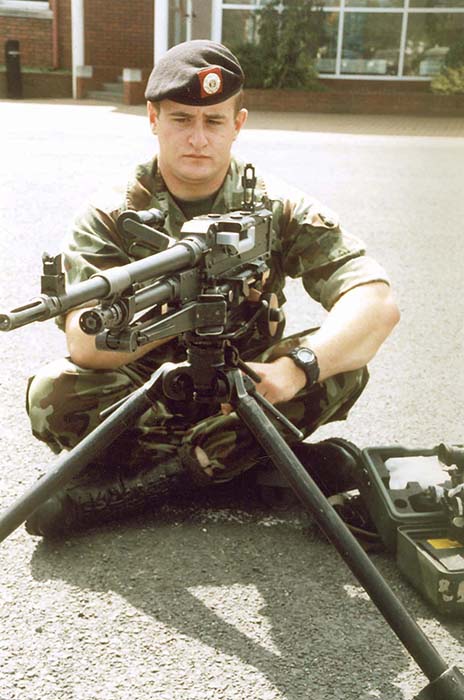
IRISH CAVALRY AND SUPPORT
At one point, the Irish Cavalry had 51 combat armored cars and 14 light tanks, and there were 47 Panhard VTT/M3 APCs. These assets were supplemented with some five locally-made Timoney Mk6 APCs.
Although 51 Panhards and most of the M-3 APCs were locally upgraded with new diesel engines, night vision equipment and laser sights, few remain now in service. The AML-H60 was converted to AML-20 by replacing the 60mm mortars with a G-12 20mm cannon. The Army retains the Scorpions, 15 AML-H90 and 18 AML-20 armored combat vehicles. Until recently, the 27th and 28th Infantry Battalions still operated the last 14 AML-VTT APCs pending their replacement with the new Piranhas. The first unit equipped with the new APC has been the 3rd Battalion, operating 16 of them. The total order covers 65 vehicles of which 40 have been delivered.
There are 24 L-118 105mm howitzers, acquired second hand from excess from the Falkland war. The 25-pounders have been finally retired. For air defense there were 24 elderly L/60 and 2 newer L/70 40 mm cannons, and seven RBS-70 launchers. They have been reinforced with 30 additional L/70 acquired in the Netherlands last year. The present status of the L/60s is unknown.
Footnotes:
- The first one of Jane’s Information Group and the second with Killiney Travel
- Who could not meet us due to being away in Croatia at the time.
- Ireland uses the British spelling or Celt.
- Similar in design and concept to the USN Whidbey Island class, but much smaller at around 4,000 tons.
- On paper, since further troops reductions are on schedule.
| This article first appeared in Small Arms Review V7N9 (June 2004) |



